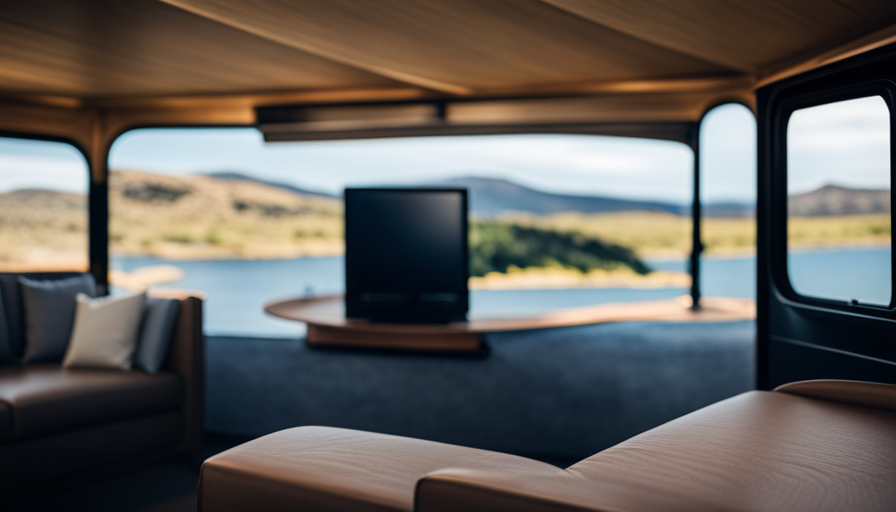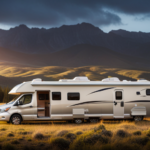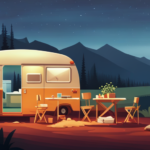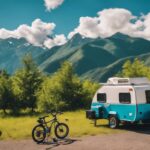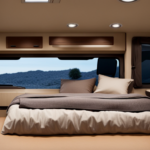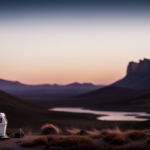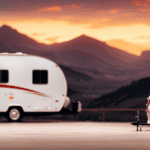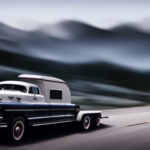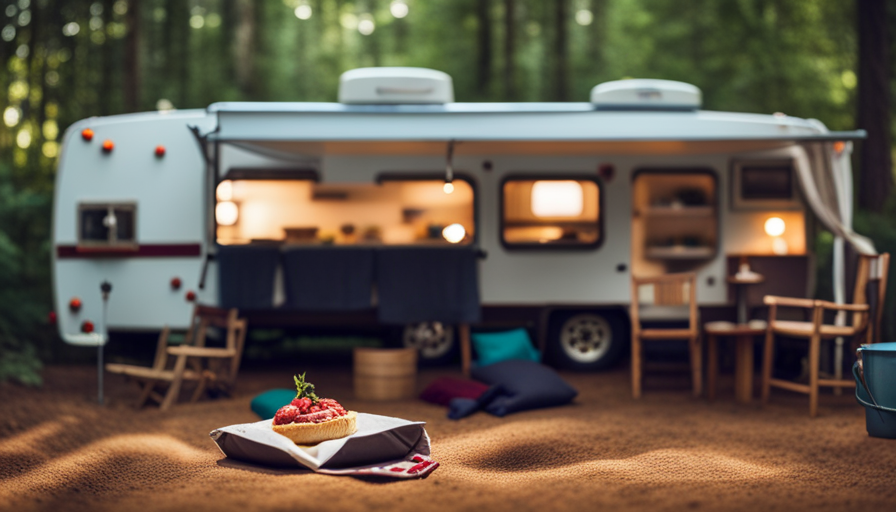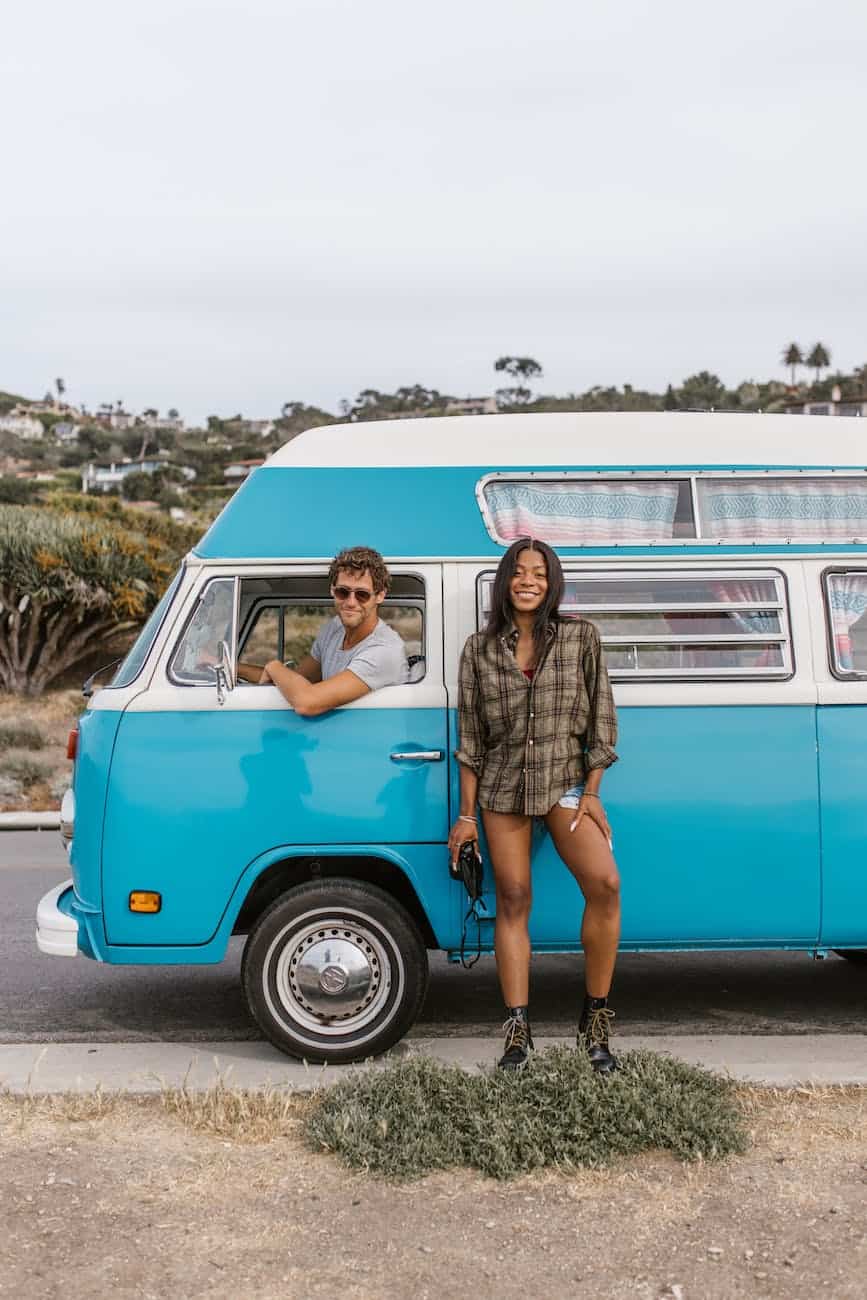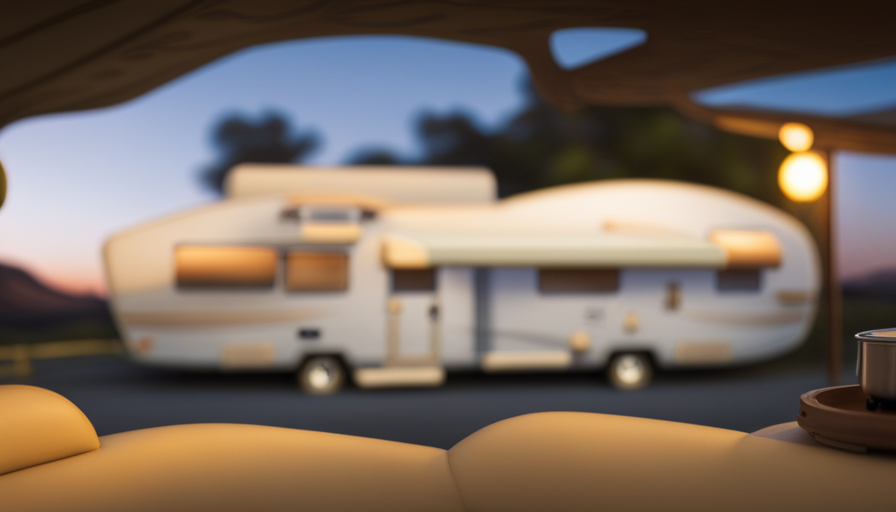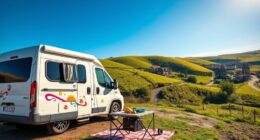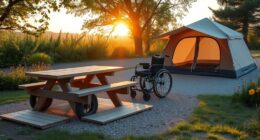Have you ever fantasized about embarking on a road trip with all your beloved toys in tow? Allow me to introduce you to the world of toy hauler campers. These multifunctional RVs are built to not only provide living space but also accommodate your motorcycles, ATVs, or any other recreational gear you can think of.
Imagine cruising down the highway with the wind in your hair, knowing that your toys are securely stowed in the back, ready for adventure at a moment’s notice. Toy hauler campers offer the perfect blend of comfort and convenience, allowing you to enjoy the great outdoors without sacrificing the comforts of home.
In this article, we will explore the ins and outs of toy hauler campers, from the different types available to the features you should consider when choosing one. We will also provide tips for packing and organizing your toys, as well as highlight popular brands and models.
Whether you’re a seasoned RV enthusiast or a novice looking for a new way to explore, this article will help you determine if a toy hauler camper is the right fit for your next adventure.
Key Takeaways
- Toy hauler campers are RVs designed for outdoor enthusiasts, offering comfort and convenience.
- They have a large cargo area at the back with a ramp door for easy loading and unloading.
- Toy hauler campers allow you to bring along all your favorite recreational equipment.
- Factors to consider when choosing a toy hauler camper include size, weight, towing capacity, and amenities.
Overview of Toy Hauler Campers
Toy hauler campers are specifically designed to transport and accommodate recreational vehicles, making them the perfect choice for adventure enthusiasts. These campers are equipped with a large, open cargo area at the back, allowing you to easily load and transport your toys, such as motorcycles, ATVs, or bicycles. The cargo area is typically accessible through a ramp door, which makes loading and unloading a breeze.
One of the main benefits of toy hauler campers is their versatility. Not only can you transport your toys, but you can also use the cargo area as a multi-purpose space. It can be converted into a living area, a bedroom, or even a workspace, depending on your needs. This flexibility allows you to make the most out of your camping experience.
When it comes to organizing your toys in the camper, there are a few tips to keep in mind. Utilize storage solutions such as shelves, hooks, and bins to keep everything in its place. Secure your toys with straps or bungee cords to prevent any shifting during transit. Additionally, make sure to distribute the weight evenly to maintain stability on the road.
Overall, toy hauler campers offer numerous benefits for adventure enthusiasts. From their ability to transport and accommodate recreational vehicles to their versatility and organization options, these campers truly enhance the camping experience.
Next, let’s explore the various benefits of a toy hauler camper.
Benefits of a Toy Hauler Camper
One of the greatest advantages of a toy hauler camper is the ability to bring along all your favorite recreational equipment, allowing you to fully embrace the thrill and excitement of your outdoor adventures. Whether you enjoy off-roading, biking, kayaking, or any other outdoor activity, a toy hauler camper provides the perfect solution for transporting and storing your gear.
With a spacious garage area at the back of the camper, you can easily load and unload your equipment, making it convenient and hassle-free.
Another reason to choose a toy hauler camper is the versatility it offers. When you reach your destination, you can transform the garage area into a living space, creating additional sleeping quarters or a comfortable lounge area. This flexibility allows you to maximize the use of space and accommodate more people, making it ideal for families or groups of friends.
Additionally, toy hauler campers often come equipped with amenities such as a fully functional kitchen, bathroom, and sleeping quarters, providing all the comforts of home while you’re on the road. This makes them a great option for extended trips or for those who prefer a more luxurious camping experience.
In the next section, we’ll explore the different types of toy hauler campers available, each offering unique features and benefits to suit various needs and preferences.
Types of Toy Hauler Campers
When you’re considering a toy hauler camper, it’s important to explore the different types available to find the perfect fit for your needs and preferences. There are several types of toy hauler campers on the market, each with its own unique features and advantages.
The first type is the travel trailer toy hauler, which is towed behind a vehicle and offers a spacious living area and a separate garage for storing your toys. This style is popular among those who want the convenience of a separate garage space without the need for a large, motorized RV.
Another option is the fifth wheel toy hauler, which is designed to be towed by a pickup truck. These campers typically offer more living space and storage capacity compared to travel trailers, making them a great choice for those who plan to spend extended periods of time on the road.
There are motorhome toy haulers, which combine the convenience of a motorhome with the versatility of a toy hauler. These campers offer all-in-one convenience, with a living area, garage, and engine all in the same vehicle.
When comparing the pros and cons of different toy hauler camper styles, it’s important to consider factors such as size, weight, towing capacity, and amenities. Must-have accessories for toy hauler campers include tie-downs for securing your toys, ramps for easy loading and unloading, and extra storage solutions for organizing your gear.
Considering these features, it’s clear that choosing the right toy hauler camper is a crucial step in ensuring a comfortable and enjoyable camping experience. Transitioning into the next section about features to consider when choosing a toy hauler camper, it’s important to also think about the layout and amenities that will best suit your needs.
Features to Consider When Choosing a Toy Hauler Camper
When choosing a toy hauler camper, there are several important features to consider.
First, the garage size and layout is crucial in determining the amount of space available for storing and transporting your toys.
Additionally, the living space amenities should be taken into account, including the kitchen, bathroom, and sleeping arrangements.
Lastly, it’s essential to consider the towing capacity and vehicle compatibility to ensure that your toy hauler camper can be safely and efficiently towed by your vehicle.
Garage Size and Layout
The garage in a toy hauler camper is like a spacious cavern, ready to store all your adventure gear. When considering the garage size and layout, it’s important to think about garage organization and maximizing space.
One key feature to look for is adjustable tie-down points, which allow you to secure your equipment in place during transportation. Additionally, having a ramp door with a low angle makes loading and unloading your gear a breeze.
Some toy haulers also offer versatile garage layouts, with fold-away beds or sofas that can be transformed into a comfortable living space. This allows you to make the most of the available square footage.
As you transition into the subsequent section about living space amenities, it’s important to consider how the garage and living space are seamlessly connected, creating a cohesive and functional space for your adventures.
Living Space Amenities
Imagine a cozy oasis on wheels, complete with all the amenities you need for a comfortable and luxurious living space during your adventures. In a toy hauler camper, the living space design is carefully crafted to maximize every inch of the available area.
Here are four key features that make the living space truly exceptional:
-
Spacious Layout: The open floor plan creates a sense of airiness, allowing for easy movement and socializing.
-
Comfortable Furniture: Plush sofas, recliners, and beds provide a cozy spot to relax and unwind after a long day of outdoor activities.
-
Well-Equipped Kitchen: The kitchen is equipped with modern appliances, ample counter space, and storage solutions to make cooking an enjoyable experience.
-
Clever Storage Solutions: From overhead cabinets to hidden compartments, toy hauler campers offer smart storage options to keep your belongings organized and easily accessible.
With these thoughtful amenities, you can enjoy the comforts of home wherever your adventures take you.
Now, let’s transition to the next section about towing capacity and vehicle compatibility.
Towing Capacity and Vehicle Compatibility
Get ready to hit the road with your adventure companion—your toy hauler camper—by understanding its towing capacity and compatibility with your vehicle.
The towing capacity of a toy hauler camper refers to the maximum weight that it can safely tow behind a vehicle. It’s crucial to know this capacity to ensure a smooth and safe journey.
Before purchasing a toy hauler camper, make sure to check your vehicle’s towing capacity and ensure that it’s compatible with the weight of the camper when fully loaded with your toys and gear. This will prevent any issues such as excessive strain on your vehicle’s engine or braking system.
Once you have determined the appropriate towing capacity and verified vehicle compatibility, you can start planning for your adventure.
Next, we’ll discuss tips for packing and organizing your toys in a toy hauler camper.
Tips for Packing and Organizing Your Toys in a Toy Hauler Camper
Maximize your storage space and keep your toys secure by utilizing clever packing techniques in your toy hauler camper. When it comes to packing tips for a toy hauler camper, organization is key.
Start by making a list of all the toys and equipment you plan to bring along, and then prioritize them based on how often you’ll use them. This will help you determine the best placement for each item.
One helpful organizing strategy is to invest in storage bins or containers that fit in the storage compartments of your toy hauler. Label each bin with the contents inside, such as camping gear, water toys, or tools, to make it easier to locate items when needed.
Another tip is to use bungee cords or cargo nets to secure larger items, like bikes or kayaks, to the walls or floor of the toy hauler, preventing them from shifting during travel.
Additionally, consider utilizing the space underneath furniture or beds for additional storage. You can use vacuum-sealed bags to compress clothing or bedding, making more room for other items. Remember to distribute the weight evenly throughout the camper to maintain balance and stability while towing.
By following these packing and organizing strategies, you’ll be able to make the most of your storage space and keep your toys safe and secure during travel. Transitioning into the next section on maintenance and care for toy hauler campers, it’s important to also keep your camper in top condition to ensure its longevity and enjoyment.
Maintenance and Care for Toy Hauler Campers
Now that we’ve discussed tips for packing and organizing your toys in a toy hauler camper, let’s shift our focus to the important topic of maintenance and care for toy hauler campers.
Proper maintenance is crucial in ensuring the longevity and functionality of your camper, as well as preventing any potential issues that may arise. Here are some helpful maintenance tips to keep in mind:
-
Regular Cleaning: Keep your toy hauler camper clean both inside and out. This includes regular washing, waxing, and cleaning of the interior to prevent dirt, grime, and mold buildup.
-
Check and Maintain Fluid Levels: Regularly check and top-up fluid levels such as oil, coolant, and brake fluid to ensure optimal performance and prevent any potential engine or mechanical issues.
-
Inspect and Maintain Tires: Regularly inspect the condition and pressure of your camper’s tires. Replace any worn-out tires and ensure proper inflation to prevent blowouts and accidents.
-
Address Common Issues: Be aware of common issues such as electrical problems, plumbing leaks, and roof damage. Regularly inspect and address these issues promptly to prevent further damage and costly repairs.
By following these maintenance tips, you can ensure that your toy hauler camper stays in excellent condition and provides you with many enjoyable adventures.
Now, let’s dive into the next section where we will explore popular toy hauler camper brands and models.
Popular Toy Hauler Camper Brands and Models
Ensure you choose from the wide range of popular brands and models when selecting a toy hauler camper, as this will maximize your options and help you find the perfect fit for your needs.
Among the popular toy hauler camper brands, Keystone, Forest River, and Heartland stand out as leaders in the industry. Keystone offers a variety of models, including the Impact, Fuzion, and Raptor, which are known for their durability and innovative features.
Forest River’s XLR and Vengeance models are also highly regarded for their quality construction and spacious interiors.
Heartland’s Cyclone and Torque models are known for their luxurious amenities and stylish designs.
When it comes to the best toy hauler camper models, the Keystone Raptor 356 and the Forest River XLR Nitro 35DK5 are often praised for their versatility and functionality. These models offer ample living space, well-designed cargo areas, and modern amenities that cater to both comfort and convenience.
Transitioning into the subsequent section about rental options for toy hauler campers, it’s important to consider your specific needs and preferences when choosing a brand and model. Renting a toy hauler camper allows you to experience different brands and models before making a long-term commitment.
Rental Options for Toy Hauler Campers
Get ready to embark on an unforgettable adventure by exploring the exciting rental options available for these versatile mobile homes on wheels. When it comes to RV rental options, toy hauler campers offer a unique and practical solution for those seeking both living space and storage for their outdoor toys.
One of the advantages of renting a toy hauler camper is the flexibility it provides. With its spacious interior and separate garage area, you can easily customize the layout to suit your needs. Whether you’re planning a family camping trip or a weekend getaway with friends, the toy hauler camper allows you to bring along all the gear you need, from motorcycles and ATVs to kayaks and bicycles.
Renting a toy hauler camper also gives you the opportunity to experience the freedom of the open road without the commitment of ownership. You can choose from a variety of models and sizes, depending on your preferences and the number of people in your group. Plus, many rental companies offer additional amenities and services, such as delivery and setup, to make your trip even more convenient.
As you delve into the world of toy hauler campers, it’s important to consider real-life experiences and testimonials from owners. These firsthand accounts can provide valuable insights and help you make an informed decision about whether renting a toy hauler camper is the right choice for your next adventure.
Real-life Experiences and Testimonials from Toy Hauler Camper Owners
Embarking on a thrilling journey with a versatile mobile home on wheels, we, as owners of toy hauler campers, have had our fair share of real-life experiences and unforgettable adventures. These vehicles have allowed us to explore new destinations and indulge in our favorite outdoor activities with ease.
One of the most valuable aspects of owning a toy hauler camper is the ability to bring along all our gear, including motorcycles, ATVs, and bicycles. This convenience has opened up a whole new world of possibilities for us, as we can now embark on off-road adventures and explore remote trails that were previously inaccessible.
Of course, like any other investment, there are pros and cons to consider. On the positive side, toy hauler campers provide ample living space and storage options, making them ideal for extended trips. Additionally, the versatility of these vehicles allows us to use them as a regular camper when we don’t need to transport any toys.
On the downside, toy hauler campers tend to be larger and heavier than traditional campers, which can make maneuvering and parking a bit more challenging. Additionally, the cost of purchasing a toy hauler camper is generally higher than that of a standard camper.
Despite these potential drawbacks, the experiences and adventures that we’ve had with our toy hauler campers have far outweighed any negatives. So, if you’re considering purchasing one, make sure to do your research, read testimonials from other owners, and take into account your specific needs and preferences. After all, the joy and excitement of owning a toy hauler camper might just be the perfect fit for you.
Transitioning into the subsequent section about the conclusion: Is a toy hauler camper right for you?
Conclusion: Is a Toy Hauler Camper Right for You?
Are you ready to embrace the thrill of owning your own versatile mobile home on wheels and embark on unforgettable adventures? Before making a decision, let’s weigh the pros and cons of owning a toy hauler camper.
One of the biggest advantages is the versatility it offers. With a toy hauler camper, you can bring along all your favorite outdoor toys, such as motorcycles, ATVs, or kayaks, without the need for an additional trailer. This allows you to have all your gear conveniently stored in one place.
Additionally, toy hauler campers often have spacious living areas, offering plenty of room for family and friends to relax and enjoy the camping experience.
However, there are a few drawbacks to consider. Toy hauler campers tend to be larger and heavier than traditional campers, which can make towing and maneuvering more challenging. Additionally, the extra space for toys means less living space inside the camper. So, if you prioritize comfort and luxury over hauling equipment, a traditional camper might be a better fit for you.
Now, let’s talk about the cost comparison. Toy hauler campers generally come with a higher price tag compared to traditional campers. The additional features and storage space contribute to this higher cost. Furthermore, toy hauler campers may require a larger, more powerful vehicle for towing, which can also add to the overall expense.
Owning a toy hauler camper can provide a thrilling and convenient adventure experience. However, it’s important to carefully consider the pros and cons, as well as the cost comparison, to determine if it’s the right choice for you and your lifestyle.
Frequently Asked Questions
How do I properly secure my toys in a toy hauler camper?
To properly secure our toys in a toy hauler camper, we need to take a few important steps. First, make sure all items are properly strapped down using high-quality tie-down straps. This will prevent any movement during transportation.
Additionally, use padded covers or blankets to protect delicate surfaces from scratches or dings. It’s also crucial to distribute the weight evenly and avoid overloading the camper.
By following these guidelines, we can effectively prevent damage to our toys while traveling in a toy hauler camper.
Are there any weight restrictions for the toys I can bring in a toy hauler camper?
When it comes to weight restrictions for toys in a toy hauler camper, it’s essential to consider the safety and stability of the vehicle. Manufacturers typically provide specific weight limits for toy storage, ensuring the camper remains balanced during travel. These restrictions help prevent any potential accidents or damage to the camper.
By adhering to these guidelines, you can confidently transport your toys without compromising the overall performance and enjoyment of your toy hauler camper.
Can I live full-time in a toy hauler camper?
Yes, living full-time in a toy hauler camper is possible. However, there are certain considerations to keep in mind.
Firstly, living expenses can vary depending on factors such as campground fees, utilities, and insurance. It’s important to budget for these costs accordingly.
Additionally, maintenance costs should be factored in, including regular maintenance and repairs.
Overall, living in a toy hauler camper can be a cost-effective and flexible option, but careful planning is essential.
Are there any special driving considerations for towing a toy hauler camper?
When it comes to towing a toy hauler camper, there are indeed some special driving considerations to keep in mind. First and foremost, you’ll need to invest in special towing equipment, such as a weight distribution hitch and sway control system, to ensure a safe and stable towing experience.
Additionally, it’s important to familiarize yourself with the towing speed limits in your area, as these may differ from regular vehicle speed limits. By adhering to these precautions, you can confidently hit the road with your toy hauler camper.
What are the advantages of a toy hauler camper over a traditional RV?
When comparing a toy hauler camper to a traditional RV, there are several advantages to consider. One major advantage is the versatility offered by the toy hauler’s design. The rear cargo area can be used as a garage or storage space for motorcycles, ATVs, or other recreational equipment.
Additionally, the open floor plan of a toy hauler camper allows for more living and sleeping space.
Safety precautions for towing a toy hauler camper include ensuring proper weight distribution, using appropriate hitch systems, and practicing safe driving techniques.
What Are the Key Differences Between a Park Model Camper and a Toy Hauler Camper?
A park model camper explanation is needed to identify the key differences between a park model camper and a toy hauler camper. While both provide compact living spaces, park model campers are designed for long-term stays and resemble a small home. On the other hand, toy hauler campers feature a garage area to transport motorized toys, making them ideal for adventure enthusiasts.
Conclusion
In conclusion, after exploring the world of toy hauler campers, we find ourselves torn between excitement and hesitation. The thought of venturing into the great outdoors, while bringing along our beloved toys, fills us with a sense of adventure and freedom.
However, the responsibility of packing and organizing can be daunting. It’s a delicate balance between convenience and organization. Ultimately, whether a toy hauler camper is right for you depends on your individual needs and preferences.
So, take a moment to weigh the pros and cons, and embark on your own journey of discovery.


